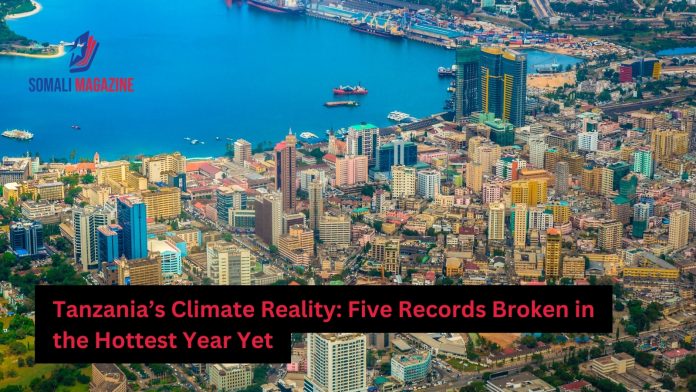Facebook Twitter Instagram Somali Magazine - People's Magazine
Tanzania is grappling with the harsh realities of climate change as 2025 emerges as the hottest year in the nation’s recorded history. With five significant climate records broken, the country is facing unprecedented challenges that underscore the urgent need for climate adaptation and mitigation strategies.
The first record shattered was the highest average annual temperature, which reached an alarming 29.3°C, surpassing the previous record set in 2019. This spike in temperature has been attributed to a combination of global warming and localized weather patterns exacerbated by deforestation and urbanization. The heatwave has had widespread impacts, from reduced agricultural yields to increased health risks, particularly for vulnerable populations.
The second record involved the longest consecutive dry spell, which lasted 72 days in the central regions of Dodoma and Singida. This prolonged drought has devastated crops and livestock, leaving thousands of families struggling to access food and water. Farmers in these areas have reported significant losses, with maize and sorghum yields dropping by over 40% compared to previous years.
Tanzania also experienced its highest-ever recorded nighttime temperature, with the mercury failing to drop below 30°C in coastal regions like Dar es Salaam and Tanga for several nights in January. This phenomenon, known as tropical nights, has disrupted sleep patterns and increased energy consumption as residents rely heavily on air conditioning and fans to cope with the heat.
The fourth record was the highest single-day rainfall, recorded in Mwanza, where 250 millimeters of rain fell within 24 hours. While this broke a long-standing record, it also caused severe flooding, displacing over 10,000 people and damaging critical infrastructure, including roads and bridges. The floods have highlighted the dual challenges of extreme heat and erratic rainfall patterns, both of which are becoming more frequent due to climate change.

Finally, the year saw the highest-ever recorded sea surface temperatures along Tanzania’s coastline, reaching 31°C. This has had devastating effects on marine ecosystems, particularly coral reefs, which are experiencing widespread bleaching. The loss of coral reefs threatens biodiversity and the livelihoods of coastal communities that depend on fishing and tourism.
The impacts of these climate records are being felt across all sectors of Tanzanian society. Health experts have reported a surge in heat-related illnesses, including dehydration and heatstroke, while hospitals in urban areas are struggling to cope with the increased demand for medical care. The energy sector is also under strain, with hydropower generation declining due to reduced water levels in key reservoirs.
Environmentalists and policymakers are calling for urgent action to address the root causes of these climate challenges. The Tanzanian government has pledged to accelerate its climate adaptation efforts, including reforestation programs, investment in renewable energy, and the development of climate-resilient infrastructure. However, funding remains a significant barrier, with many initiatives reliant on international support.
The international community has also taken note of Tanzania’s plight, with organizations like the United Nations and the World Bank emphasizing the need for global cooperation to combat climate change. Analysts warn that without immediate action, the frequency and intensity of extreme weather events will continue to rise, posing a severe threat to Tanzania’s development goals.
As Tanzania navigates this new climate reality, the focus remains on building resilience and fostering sustainable practices. The records broken in 2025 serve as a stark reminder of the urgent need for collective action to mitigate the impacts of climate change and protect the planet for future generations.

